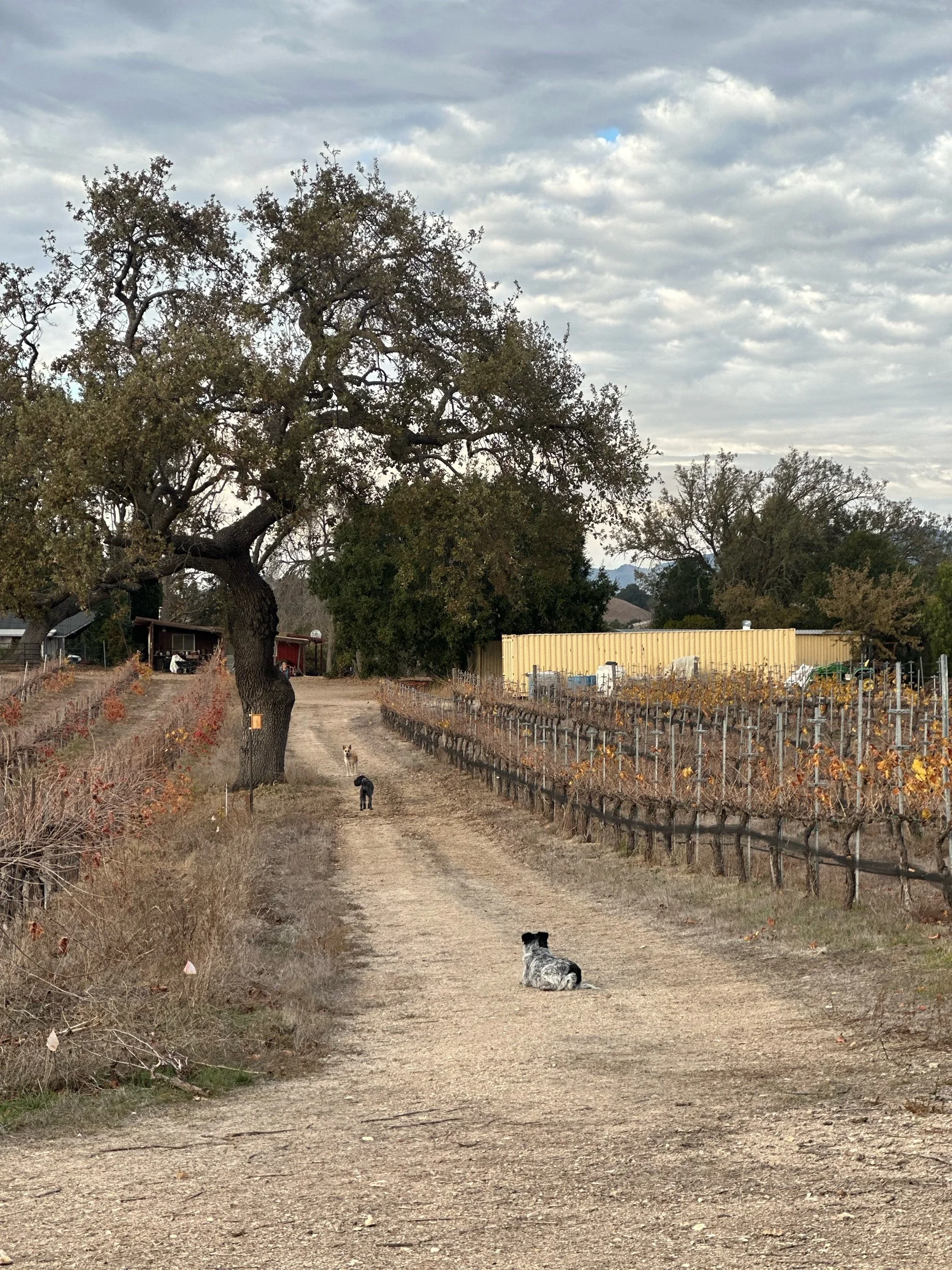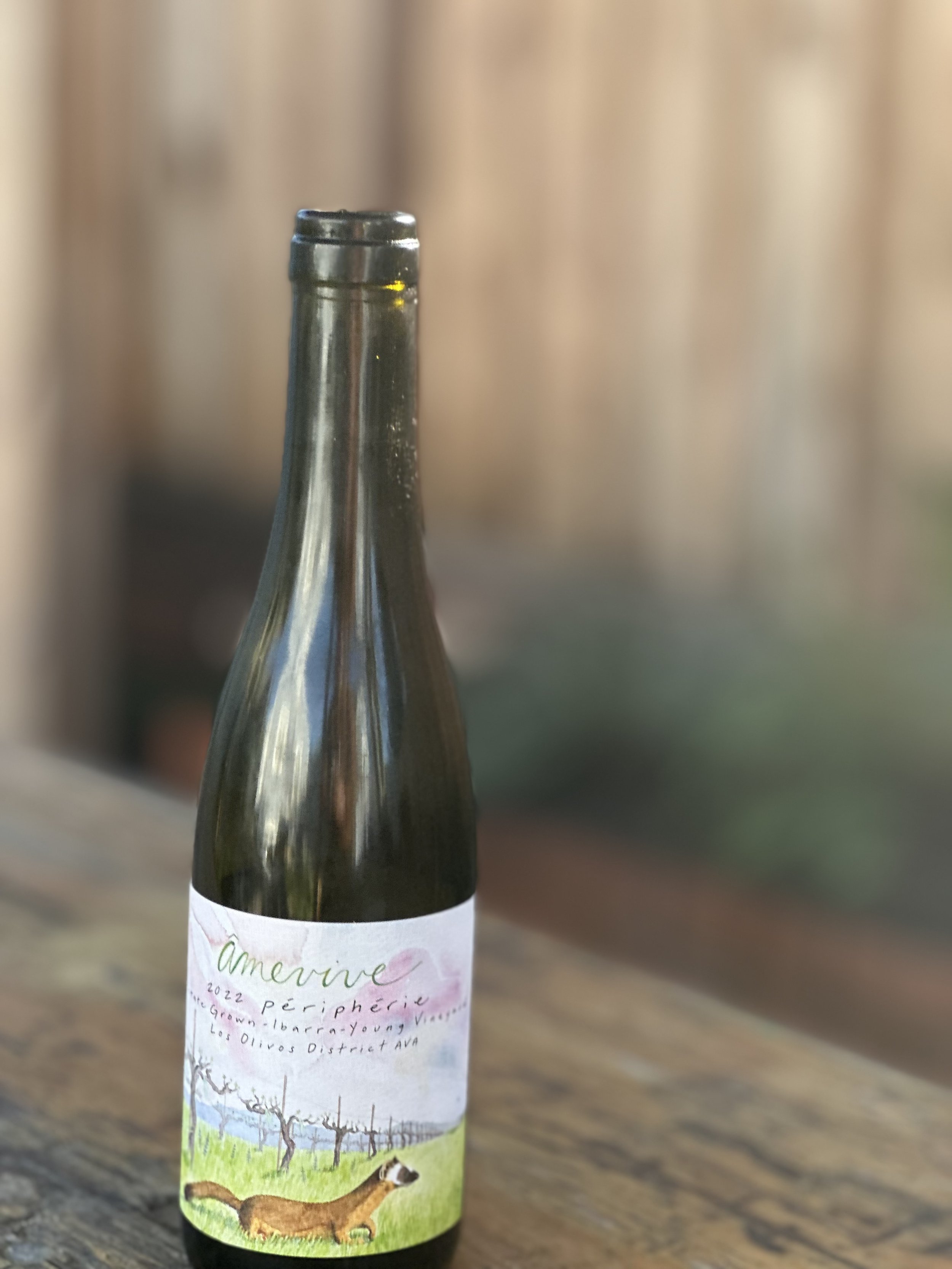The Mediterranean Side to Santa Barbara
I’m just back from a brief visit to Santa Barbara, visiting friends and some wineries. First thing to note, it’s a long way from Sonoma County where I live—a good six hours’ drive. Second thing to note, it’s a fair distance from Los Angeles—the last time I visited Santa Barbara wine country, I was staying in LA and it was a three-hour drive. Third thing to note, wine country is a 40-60 minute drive from the city of Santa Barbara, which lies on the coast with lots of palm trees. All of which is to say, Santa Barbara’s vineyards aren’t that near anywhere which gives the region a quirky, individual, rural feel and in part explains why the first plantings of vines weren’t until the late 1960s and early 1970s.
The geography of Santa Barbara is quite unique. Sta. Rita Hills is the only mountain range on the entire Pacific coast which is formed in an east/west direction—all others are north/south. This channels breezes into and across the various valleys, cooling growing conditions and creating localised climates, giving site specificity to the wines and making it difficult—in a welcome way—to generalise about them. The climate is much cooler towards the coast, getting warmer further inland. Sta. Rita Hills is the coolest AVA in California, although visiting in December with temperatures hitting 25°C perhaps indicates what cool means in California. Further inland in an AVA such as Happy Canyon, Bordeaux varieties are more common; nearer the coast, Pinot Noir and Chardonnay are grown and have shaped perceptions of Santa Barbara wines. The paradox of Santa Barbara in the coolish climate, however, is that Grenache and Syrah excel, with Nebbiolo and Sangiovese showing potential. Maybe it’s best to think of Santa Barbara as a cool pocket within a warm Mediterranean climate: the wines are certainly different from Paso Robles a couple of hours to the north.
avas
There are seven AVAs within Santa Barbara County, all clustered together north-west of Santa Barbara. To the north is the fairly large Santa Maria Valley AVA, in which lies the famous Bien Nacido vineyard, first planted in 1973; the AVA is best known for Chardonnay and Pinot Noir, shaping the reputation of Santa Barbara’s wines through long-standing wineries such as Au Bon Climat. To the south is the overarching Santa Ynez AVA, in which lie, from west to east and therefore cooler to warmer, Sta. Rita Hills, Ballard Canyon, Los Olivos District, and Happy Canyon. There is a new AVA between Santa Maria Valley and Santa Ynez called Alisos Canyon. Confusingly, the sub-district of Los Alamos, west of Alisos Canyon, doesn’t have its own AVA, although you may find it on labels as there is lots of good wine from there.
rhône/mediterranean varieties
Santa Barbara has become best known for Pinot Noir and Chardonnay, both of which have the richness expected of California but with a lean structure from the cooler climate. Further inland, in AVAs such as Happy Canyon, Bordeaux varieties are successfully grown though it’s tricky to know where they fit in the market outside the area as they taste neither like Bordeaux nor like Napa. That’s a good thing, but it makes them hard to place.
On this trip, I realised the most exciting wines are being made from Rhône/Mediterranean varieties such as Grenache, Syrah, Mourvèdre, and even some Carignan. I visited Alice Anderson of Âmevive, who is quickly gaining a reputation as a young winemaker to watch. Her passion is viticulture, and she farms some of the leading vineyards for producers such as Domaine de la Côte and Holus Bolus. For her own wines, since 2019 she has farmed the oldest existing vineyard in Santa Barbara, planted in 1971 just outside the town of Los Olivos (in which there are plenty of tasting rooms to visit). The original vines are Marsanne, Syrah, and Mourvèdre, an indication of the suitability of Rhône/Mediterranean varieties to the region. That’s further proven by additional plantings in the 1990s of Marsanne, Graciano, and Tempranillo by Bob Lundquist of Qupé—one of the earliest champions of Rhône/Mediterranean varieties in California.
Âmevine “Péripherie” is a blend from the property of 40% Marsanne, 40% Syrah, and 20% Mourvèdre, all co-fermented. I love the irreverent approach, it’s very Californian. But I also love that it’s an entirely Rhône/Mediterranean blend, a tribute to both the northern and southern Rhône and to Spain. Its light, high acid, and crunchy red fruits are the perfect introduction to an alternative Santa Barbara.
syrah
Sta. Rita Hills has garnered a reputation for peppery Syrah, and rightly so. I visited Camins 2 Dreams, a project started in 2017 by Native American Tara Gomez and Catalan Mareia Taribó. Camins 2 Dreams make several single-vineyard wines from Syrah. Donnachadh is meaty and gamey, with black fruit, black liquorice, black pepper aromas; Spear Vineyards is smoky, meaty, and juicy, with a briny, black olive character; John Sebastiano Vineyard is weighty but lively with a long, spicy finish. (They also make a lovely Carignan, which is 50% carbonic, further proof of Santa Barbara’s suitability to Mediterranean varieties.)
Âmevive’s Los Olivos Syrah comes from the original vines planted on the property. Fermentation is all whole cluster and open top and the style is more floral, with characteristic black pepper aromas.
From previous tastings, it’s been clear that Syrah is ideal for the cooler climates of Sta. Rita Hills and Los Olivos—an impression that has been confirmed.
grenache
Camins 2 Dreams make a Grenache from the Christy and Wise Vineyard, which shows that everything you learn about Grenache is wrong. There’s no problem ripening the grapes in a cool to moderate climate (alcohol is 14.8%), and the wine is intense, tannic, and high in acid, with red and black fruit, spice, and herbal aromas.
Another visit was to A Tribute to Grace, where the winemaker is Kiwi Angela Osborne. The winery was established in 2007, and is solely dedicated to Grenache. There’s a rosé which has 24-hour skin contact for a pale-coloured, high acid, light-bodied style with herbal, rose petal aromas. The Grenache Blanc is rich, nutty, waxy, with a grainy texture and stone and tropical fruit aromas—Âmevive also have a Grenache Blanc similar in texture and style. There’s also a sparkling wine for which the Grenache grapes are picked very early. Spending three years on the lees, it’s toasty and spicy and also wonderfully fresh.
But it’s the red wines that A Tribute to Grace are best known for. There are single-vineyard wines (Angela also makes one from the acclaimed Shake Ridge Ranch in Sierra Foothills): the Thompson Vineyard is deep and dark, with paprika, black liquorice aromas; the Santa Barbara Highlands Vineyard is more garnet and red-fruit driven. The Santa Barbara Grenache is a blend of four vineyards, and is everything that’s great about Grenache: red fruits, herbal, liquorice, fresh, with fine tannins. These wines prove the wonderful versatility of Grenache, how it so keenly expresses site, and how it’s well-suited to the climate of Santa Barbara.
other varieties
Both Âmevive and Camins 2 Dreams make Gamay, and both feature whole-cluster fermentations. The Camins 2 Dreams Gamay comes from Portico Hills Vineyard in Los Alamos district. 20% whole cluster, there’s a jalapeño feel alongside a juicy fruitiness. The Âmevive Gamay is 100% whole cluster, with high acid, a good tannic grip, with sweet spice, red fruit aromas. Although there isn’t that much planted, it’s not surprising that very good wines can be made from Gamay in the climate of Santa Barbara. Tasting Gamay and Syrah next to each other gives a sense that we are not in Burgundy, but somewhere between Beaujolais and Côte Rôtie yet near the ocean.
Both wineries also make Albariño, a fashionable variety that is often grown by the coast. The wines were a little fuller and richer and a little less saline than Galician equivalents, but maintaining high acidity and the characteristics of Albariño: floral, tropical, creamy, and spicy.
Camins 2 Dreams also work with Grüner Veltliner. From Fiddlestix Vineyard, one of the older sites in the region, the Grüner is only 11% ABV, very fresh, with green and citrus aromas, a creamy mouthfeel, and characteristic white pepper. The Pét-Nat, 11.5% ABV, is very similar but with bubbles, and a straw, sage character. Another producer who makes Grüner is Tatomer (where Alice Anderson worked for a while; she also worked at A Tribute to Grace)—there may not be much planted, but it can clearly produce extremely good wines.
Italian varieties are also planted. Silver Wines make Nebbiolo, a variety which stubbornly refuses to make great wine outside Piemonte. The wines were good, though lacking the tannic intensity of Barolo or Barbaresco. Sangiovese is also made, with appropriate sour cherry aromas. It really is surprisingly difficult to make truly great wine out of Italian varieties outside of their native growing conditions, in contrast to Mediterranean varieties.
Revisiting Santa Barbara made me aware that the best wines aren’t necessarily Pinot Noir and Chardonnay, but from Rhône/Mediterranean varieties. Tasting the wines in situ reminded me of being in Vaucluse: no bad thing.





